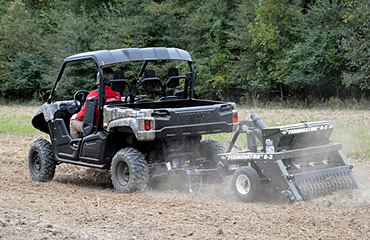Now is the time to start working toward a great food plot.
It might seem a little early to start talking about food plots, but prep work for a great food plot starts in late summer. Sure, there are many clubs and property owners who wait until fall to disc, plant and cultipack all in one weekend. That can work, especially on well established ground with good soil, but if you really want a pretty plot that doesn’t have to fight weeds to grow, the process starts now.
Actually, the process started a few weeks ago when you sent off your soil test ... right? If low pH was an issue (and it usually is), lime treatments should already be under way. It takes months for lime to dissolve and change the pH of your soil, but it’s important enough that we recommend you apply lime whenever you can, even if it’s too late to help this year. Nearly all food plot plants do best in a pH range between 6 and 7, and your soil test will tell you how much lime to apply per acre. Note there are also fast-acting lime products available. They are more expensive, and they help regulate pH for a shorter amount of time, but they can be an answer for immediate needs. If you use a fast-acting product, it’s still a good idea to apply a more traditional lime product at anther time.
Back to what you can do to help your foot plot now ... Summer is the time to get weeds under control. This is especially important for newer food plots. Start by mowing the plot area. Next, apply a herbicide. Glyphosate (Round-Up) is a great choice since it will kill everything in the plot, but there are other commercial food plot herbicides available.
Give the application a few weeks, and then come back and spray it again. Weed seeds remain dormant in the soil, so a second application gets the weeds that grow after your initial herbicide treatment. You’ll then want to wait another few weeks before you plant your food plot.
Plotting that all out on a calendar lets you see why now is the time to start the weed-killing process.
If you have a perennial plot, or you just need help with weeds later in the fall, you can’t use glyphosate since it kills everything. There are several selective herbicides that do not harm clovers, soybeans, peas or brassicas, but those same herbicides will kill other common food plot plants like corn, wheat, oats, rye and sorghum. We have recom-mended planting mixed seed blends many times in Buckmasters magazine to spread out the effectiveness of your food plot, but controlling weeds in a mixed plot is more difficult. If you’re new to food-plotting or you just want to keep things simple, select plants you know you can treat safely with one herbicide.
If all this sounds like a lot of work, that’s because it is! But the more prep work you put into your plot, especially getting weeds under control early, the more you’ll be able to relax and enjoy the fruits of your labor later this fall.
Read Recent Tip of the Week:• Tune In: Paper-tuning your bow is great, but you can tune at home, too.




.png)